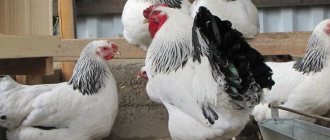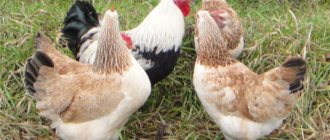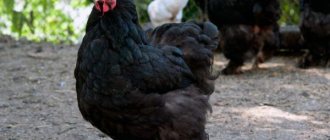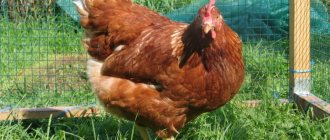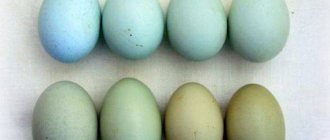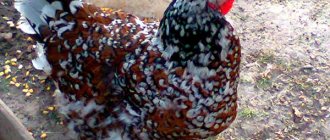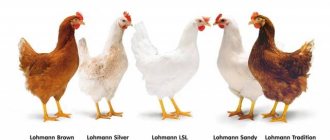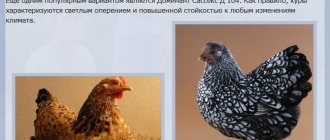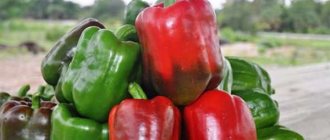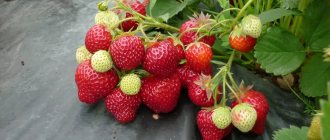Among the variety of birds of the courtyard there are egg breeds and there are decorative chickens, from which no farmer expects good egg production. The Andalusian blue breed of chickens, most often, belongs to livestock breeders to decorate the yard - the bird seems to be dressed in a shell of steel, with a bluish tint, edged feathers. And only a few months later, the breeder notices that the beauty is also an excellent laying hen. Let's take a closer look at such a unique breed of chickens.
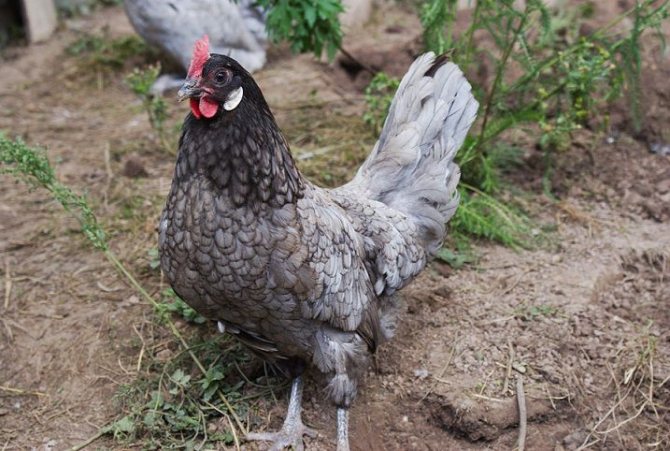
Plumage of Andalusian blue hen
Characteristics of the breed
The description of Andalusian chickens includes several distinctive qualities:
- the bird has a slender constitution, the weight of the laying hen is about 2 kg, the rooster is 2.5-2.7 kg;
- elongated earlobes, white with a smooth surface;
- the face is reddish;
- eyes are round, brown;
- light-colored skin, almost snow-white;
- the surface of the paws is light yellow with a blue tint;
- small, bluish beak;
- the crest is leaf-shaped, in chickens it is lowered to the face, in roosters it is erect.
The neck and trunk are elongated, the chest is of medium width. In males, the tail is at an angle of 90 ° in relation to the skeleton.
The belly and chest area has a lighter plumage than the back and mane. The feathers are unusual - steel blue with dark edging.
Where can one buy
You can buy hatching eggs, young or adult chickens at several poultry farms in Russia - Kurkurovo, Veselaya Ryaba, Bird Village.
The cost of seven-day-old chicks is 300 rubles, of two-week-old chicks - 350 rubles. The price for one hatching egg is 200 rubles.
External signs
We will start describing the appearance of feathered beauties by considering the weight limits. The breed lady gains about 2-2, 5 kg, and the leader of the pack weighs no more than 3 kg. Next, we will sequentially analyze all the other features of appearance.
- The standard spelled out the rules that the Andalusian blue breed of chickens must comply with. The first rule is the presence of a well-developed scarlet ridge. But, there is a small nuance - for the ladies it is dumped on its side, and for the cockerels it is erect.
- The physique of different sexes is also slightly different. Firstly, the leader is slightly larger, and secondly, they have a more elongated body and a long neck. The body of the cockerels can even be called "embossed", because the contours of each part of the body are noticeably outlined. Chickens are slightly shorter in stature, but at the same time they have the same strong and well-formed body with a protruding tummy.
- The head is elongated, and the skin on the face is red, and slightly covered with stubble. The earlobes are large enough, have the shape of an elongated oval, and their color is snow-white.
- Paws and beak are painted in the same shades - gray-blue.
- And the most important thing is color. The "fur coats" of the winged beauties are colored blue - in some areas it is more saturated, and in others it is less. The feathers on the body are edged with a dark gray, saturated color.
Features of crossing
Very often you have to observe a picture when from the entire brood, only 50% of the offspring are obtained with blue plumage, the second half with white or resinous color.
The change in tone is influenced by genetics. This breed has two genotypes - black and blue. Therefore, when crossing birds with different colors, chickens can turn out to be diverse:
- some of the chicks (about 50%) will carry a combination of 2 genes;
- slightly more than 15% will be obtained with black plumage;
- a quarter are blue individuals with light blotches, which are also called splash.
When the last two are crossed, the probability of getting young animals with a rich blue color is almost 100%
Feeding
The Andalusian blue chicken is omnivorous, like any unpretentious poultry. Feeding it will not cause difficulties, since the bird is with small bones and does not need special attention to calorie content and vitamin and mineral supplements. The food can go:
- the remains of human food;
- corn;
- weed grass;
- industrial compound feed.
The egg production of the Andalusian bird will require a simple, hearty diet from childhood. Chickens eat often, 5-6 times a day. They are given:
- small cereals;
- cottage cheese;
- chopped egg;
- small greens.
Everything is mixed and offered to chicks in a low bowl. There must be water at all times - the chickens drink a lot.
You can replace the water with a 5% glucose solution in the first 3 days. This will provide an additional source of energy for the chicks.
A chick drinker is an important attribute of a poultry house.
The remnants of food are thrown away after an hour - the chicks are kept in a warm place, the food quickly deteriorates. Chickens from 7 days no longer need an egg. They can be gradually transferred to the diet of an adult chicken, keeping the fine consistency of the food until the age of two months. At 2 months, the pullets will move to joint housing with the adult population of the chicken coop and will eat from a common table.
The grain that goes into food can be anything:
- wheat;
- rye;
- corn;
- buckwheat;
- millet.
Bran is definitely added - they are useful for chickens of any age. Cereal mix cannot be the only food for the hen. She needs vitamin and mineral supplements in the form of:
- sunflower seeds (cake);
- legumes;
- fish or meat and bone meal;
- salt;
- gravel or seashells.
Fresh greens are available to birds in summer. Given the excellent forage quality and activity in the fresh air, the cost of feeding in the spring-summer period will drop sharply - the Andalusian chicken will get its own food on its own. But if a decrease in egg production is noticed, it is worth increasing the amount of the diet.
In winter, instead of greens, you can add sprouted grains of wheat, barley, rye. They will be sources of vitamins for chicken during the cold season. Leftovers from the table are a great addition to the Andalusian chicken diet.
Andalusian blue hens
Temper
Andalusian chickens have not only beautiful and unusual coloring, but also a cocky character, similar to the Spanish.
In the absence of a threat, they behave calmly; in the event of a stranger, they begin to show aggression.
In such situations, the rooster dominates the chickens and acts as the protector of the entire livestock. In order to avoid commotion in the hen house, they must be properly planted and the procedure for completing the family must be carefully approached. Since any stress can negatively affect the productivity of layers.
Birds of this breed are distinguished by their leisurely nature, they easily make contact with humans.
Temperament of chickens
One of the oldest Mediterranean breeds is distinguished by a wayward, absurd character, therefore it can be recommended for keeping only by experienced breeders. Like most good foragers, birds show the best qualities when kept free and, being somewhat wild, always remain on the alert, which, together with camouflage dark plumage and fast legs, allows them to protect themselves from predators.


The bird in general is considered a little nervous, noisy, with a constant desire to break free, the need for some activity, the best of which is fumbling in the backyard. However, when handled correctly, Andalusian blue chickens show themselves to be a reliable, unpretentious and productive breed, slightly shy.One of the undoubted advantages is that even old chickens show a reduced tendency to hatch.
Performance


Chicken does not differ in performance from other breeds
Growth and development in this breed is exactly the same as in other varieties.
The first egg production begins at the age of 6 months. In a year, one chicken can lay up to 180 eggs, some more - up to 200 eggs. But this rarely happens.
All one egg varies from 50 to 60 g. The surface is white, firm.
You should not breed this breed just for the sake of obtaining meat, because chickens are not overweight compared to broilers. The most valuable is the meat of young individuals - it tastes tender and there is practically no fat in it.
Life expectancy is 9-10 years, but a decrease in egg production can be observed as early as 4 or 5 years of breeding.
Laying hens can be kept until they die, but as they age, they become increasingly ill and their performance drops significantly. Therefore, experienced breeders recommend replacing every four years.
Andalusian chickens
There are a number of fairly rare chickens that avid zootechnicians want to get on their household.
Andalusian blue chickens are similar animals.
This breed is considered quite rare, and also fertile.
It is because of its "rarity" that the peculiarities of this breed should be studied, since if you make some stupid mistake, the animals may simply die.
Andalusian blue chickens are highly prized in hobbyist circles because of their “rarity”, as well as their excellent conformation and good performance.
These animals are almost impossible to meet in a regular farm yard, so the most avid breeders try to find young animals of this breed in order to raise them at home.
The first representatives of this breed appeared in Spain as a result of working with black and white Minorca chickens, which were crossed with blue roosters of fighting breeds.
Such “parents” were chosen so that outwardly the animals turned out to be very beautiful, gave a lot of meat and eggs.
Males of the Andalusian breed have a beautiful, strong and long body. The head of these animals is rather wide, slightly elongated, with a pronounced convex forehead.
Roosters have a very strong beak, which is slightly curved at the end, painted in gray shades. A characteristic feature of Andalusian roosters is a beautiful, upright, large comb with pronounced teeth.
On the muzzle of these chickens are short bristle feathers, and the skin is red. Eye color can be either hazel or yellow-red.
The earlobes are oval, painted in light shades. In roosters, these earrings are very soft to the touch, but outwardly they are wide and elongated. The neck of males is also long, slightly bent closer to the head.
The rib cage is rounded, voluminous. The back is also quite wide, slightly inclined closer to the tail, covered with a large number of feathers. The wings are long, attached to the body high enough, almost to the back, tightly attached to the body of the animal.
The tail is slightly curved, but well developed. Roosters of the Andalusian breed have beautiful, pronounced, long braids. Both the legs and feet of these roosters are long and strong.
Metatarsus have a bluish slate color. In chickens of this breed, the scallop is tilted to the side. Other external characteristics of females are similar to males.
The breed has several shortcomings - any malformation of the ridge, uneven surface of the earlobes, white coating on the muzzle, white color of the limbs.
Also, birds may lack a pattern on the feathers, there may be a too curled tail, a deformed comb.The disadvantages include pallor of the face and the presence of a red plaque on the feathers.
These animals attract breeders with their beautiful exterior, since blue feathers are of special value. Such animals will perfectly decorate any private yard.
Egg production in layers of this breed is very good, one female can produce 180 eggs per year, each weighing up to 60 g.
Such good indicators are usually not typical for meat and egg chickens, which also perform a decorative function. Andalusian chicken meat is very tender and tasty.
The maternal instinct in females is very poorly developed, therefore it is very difficult to breed young animals of this breed at home. The chicken weighs on average 2 kg, and the rooster weighs 2.5 kg. The survival rate of chickens is 93%, and that of adult chickens is 87%.
In the matter of care, you should be very careful about feeding young animals. Youngsters of the Andalusian breed can eat a lot of protein-containing feed. Therefore, grain and mill waste, as well as meat for disposal, small potatoes and other root crops, and greens can be introduced into the diet of chickens.
On a mandatory basis, chickens should be given 30 g of fresh herbs every day.
The diet of Andalusian chickens directly depends on the season. In summer, animals need to be fed moist food, which contains a lot of greenery. In the cold season, it is better for chickens to feed compound feed with grass flour, prepared in water or broth from fish or meat waste.
Andalusian chickens are very beautiful animals that combine not only excellent conformation, but also excellent performance indicators.
Pros and cons
The description of this breed includes several advantages:
- high decorative qualities;
- relatively good egg production;
- good survival rate in chicks is about 93%, in adults - 87%;
- great taste of meat and eggs.
It has several disadvantages:
- the desire to incubate chickens and further maternal instinct are poorly developed, therefore incubators are often used for breeding poultry;
- deformation of the ridge, which leads to a loss of decorative appearance;
- the breed is very rare and expensive - a weekly chick costs about 300, a two-week old 350, a hatching egg - 200 rubles;
- afraid of cold and sudden changes in temperature.
Breeds of blue laying hens with a description, photo and video
Hello dear readers! Everyone knows about the existence of various colors of chickens, and many prefer to choose for keeping not just workers, but also those who have decorative qualities. Breeds of blue laying hens with descriptions, photos and videos in our material. Blue chickens are some of the most unusual and attractive.
Today we will consider those breeds that are the owners of this shade of feathers. It should be noted that there are many more such beauties, but we will consider only 6 of the most popular.
In the photo there are blue Dominant chickens, read the link for more details about these super layers!
Content rules
Poultry house
Keep birds in a dry, spacious and warm room with good ventilation and no drafts. The calculation of the place is carried out as follows - at least 1 m2 is allocated for 2-3 individuals.
If the area is smaller, the risk of developing diseases and parasites is high. At a lower density, they will freeze in the hen house.
The bottom of the floor is covered with sheets of tin to exclude the possibility of rodent penetration. Then it is whitewashed with slaked lime to prevent the appearance of fungal infections. A thick layer of straw, dry peat or large sawdust is laid on top.
The laying of the flooring is carried out in dry and sunny weather, otherwise it will be saturated with dampness and can quickly become moldy. Change the litter no more than once a year.
Chicken droppings and feathers that fall on the floor help maintain the correct indoor humidity.
To eliminate the risk of injury, adults are not set too high perches - up to 50 cm from the floor surface.
Ventilation and illumination
It is important to provide good lighting for 12-13 hours a day. The illumination should not be too bright or dim. Diffused daylight, which can be created by using lamps, is suitable.
The second important condition is good ventilation. Every day, the room is ventilated by opening a window, door or cover, depending on the type of construction.
In the absence of air exchange, there is a high risk of developing pathogenic bacteria and microbes in a musty chicken coop.
The optimal temperature regime for keeping chickens is about 25 ° C. There should be no drafts that contribute to sudden temperature changes and cause colds in birds.
Place for walking
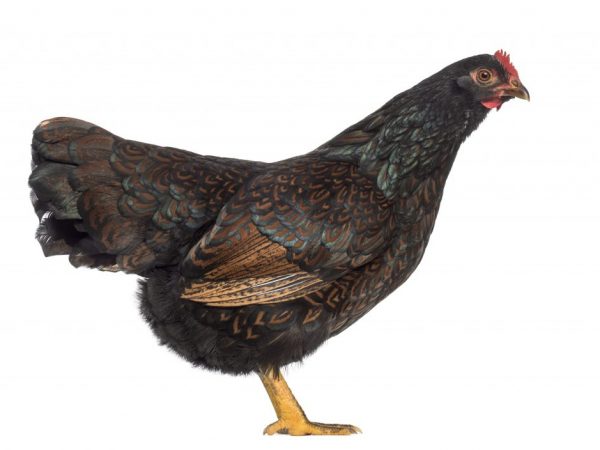

The chicken is kept in a confined space
The description of the Andalusian blue breed of chickens includes good productivity, provided they are daily walked. Therefore, you need to take care of a place for walking chickens and roosters in advance.
The walking area is fenced off with a high fence and a net is pulled from above, since this bird is capable of flying high. The soil is sown with grass of cereal crops in order to provide chickens with green fodder for the summer period in the future.
Due to increased aggression and temperament, it is not recommended to keep it together with other breeds. Frequent fighting can injure and reduce the productivity of both varieties.
Feeding ration
In the chicken coop, it is necessary to install feeders and drinkers that are convenient and accessible for each individual. This breed has a good appetite and readily eats any food. The diet includes:
- grain crops;
- weeds;
- industrial compound feed;
- leftover food from the table;
- wet mash, cooked in fish or meat broth with the addition of vegetables and cereals, are served warm.
In the summer, the amount of greens is increased, reducing the rate of grain and other feeds for the winter diet. To increase egg production in the off-season, chickens are given sprouted wheat, barley, rye. This food contains many vitamins and minerals. Additionally, layers are given gravel, shellfish, sunflower cake, legumes, fish and meat and bone meal.
You need to change the water in the drinkers every day, especially if it is a simple container with an open top. It must be fresh and clean.
For convenience, many breeders use nipple or groove designs, in which the liquid remains high quality longer.
Feeding an adult herd
For adult birds, the feeding regime is no longer as important as the diet. Andalusian layers are unpretentious in this matter, but due to errors in the compilation of the menu they can suffer. First of all, an improper diet affects their health, and as a result of this, their appearance suffers, and also performance indicators decrease. To avoid such consequences, you need to maintain a balance of essential substances in the daily diet. Here are some tips to help you make your meals complete and healthy.
- Like nothing else, protein, as well as other substances obtained from insects, larvae and worms, are suitable for meat and egg quads. Therefore, if possible, feed them with such delicacies.
- Meat and fish waste are good sources of animal protein, but they must be fresh.
- Wet mash, cooked in fish or meat broth, with the addition of vegetables and cereals, are quickly and well absorbed by bird stomachs. If it gets cold, it is advisable to serve them warm.
- In the summer, chickens find vitamins for themselves in the walking yard - they are happy to nibble the grass, but in winter it is worth using the harvested hay supplies, as well as grass or pine needles flour, so that the inhabitants of the poultry house do not suffer from vitamin deficiency.
- When the adult flock completes the growth phase, it can be switched to compound feed, which contains less protein.
First of all, let's consider in what climatic conditions a Spanish beauty can feel normal. It is quite normal for chickens to tolerate hot periods, but they have big problems with cold resistance. Therefore, they will not be able to withstand winters in regions with a harsh climate.
Poultry farmers of central Russia successfully keep these chickens, but at the same time they have to place them in heated poultry houses for the winter. The feathered beauty feels well in winter in its "native" climate - in Andalusia, the air temperature during this period does not fall below +10 degrees. In addition to climatic requirements, there are several more rules for care and maintenance.
- It is not recommended for a breed herd to be kept with representatives of other species. First, it helps maintain genetic purity. Secondly, it will help to avoid conflicts and cockfights.
- The herd is sensitive to precipitation and the scorching sun, therefore it needs a shelter under which it can hide in case of rain or heat.
- Multilevel roosts can cause injury, and outdoor maintenance can lead to a deterioration in the appearance of Hispanics. The best option is low perch-poles, at a height of up to 50 cm from the floor.
Age-related decline in egg production
The life expectancy of exotic Spanish women is approximately 10 years, but a decrease in performance indicators can be observed as early as the fourth year of life. Purely theoretically, quads can be kept while they are alive, and not make a planned replacement of the herd.
But, aging hens are more likely to get sick, and practically do not give any fruits of their activity. Therefore, it is recommended to carry out a scheduled replacement every 4 years.
Frequent illnesses
The survival rate of young and adult chickens is about 93-95%. To prevent Andalusian hens from getting sick, it is worth strictly adhering to the vaccination calendar and taking all the necessary preventive measures.
Despite the fact that this species has strong immunity, it is not protected from parasites and infectious diseases. Spaniards are prone to colds due to hypothermia and high humidity in the house. Also, often during the molting period, they suffer from vitamin deficiency.
What are the reviews?
> Benefits
- External attractiveness.
- Unpretentiousness.
- Good survival rate.
- Decent performance.
Breeding nuances
Breeding in a chicken coop is very rare, so breeders use incubators.
An important condition for the successful hatching of chicks is a selection of quality eggs. Select only fresh (not older than 5 days) without cracks, with a flat and smooth surface. Better to use medium sized specimens.
Fertilization of eggs is quite high - about 95%. After laying and until the brood appears, a certain regime is maintained in the incubator - in the first 7 days, 40 ° С, all subsequent weeks are reduced by 1 ° С. During incubation, the eggs are turned daily 3-4 times a day.
The hatched chicks are kept in a dry box at a temperature of 25 ° C with diffused daylight.
Feeding young animals
Feeding begins after the cannon has dried, when the chicks become active. The first dish is a boiled and chopped chicken egg.
From the third day of life, they are fed with cottage cheese, small herbs and cereals. Young individuals eat often, so they need to be fed at least five times a day.
Up to three weeks of age, chicks need a large amount of protein, which strengthens bone tissue and prevents the development of rickets - minerals, dairy products, fish oil, yeast are introduced into the diet. Additionally, coarse-grained, pre-calcined sand is produced.
To strengthen immunity and increase activity, instead of water, glucose (5%) is given for the first 3 days. All subsequent days offer clean, fresh water at room temperature.
Care features
The main care of chicks is to ensure a stable temperature regime within 25-27 ° C, good illumination for at least 10 hours a day.
Sawdust or straw is used as flooring in the box, which is changed every five days. On sunny days, they can be walked in the fresh air.
Starting from 2 weeks, chickens are transferred to the diet of an adult - they are given chopped feed. From the age of two months, young animals begin to be kept in a common herd.
Chickens
In general, exotic offspring are practically no different from ordinary ones. Spanish cubs are born in the same way as others - after 3 weeks. They are lightweight, about 40 grams, and their body is covered with fluffy, short gray pile.
There are also no specific rules for growing them - everything happens according to the standard scheme.
For a list of the most basic rules of feeding and care, read below.
- Within 3 weeks after birth, the chicks need to follow a strict feeding regime, because their growth and development depend on it.
- The first foods allowed for babies are cereals, herbs and boiled eggs.
- It is important to enrich the menu with protein foods to avoid growth defects. For the same purpose, it is necessary to add minerals, especially calcium, which is involved in the growth of bone tissue and the formation of the skeleton.
- From the very first days of life, you need to improve your health. For strong immunity, chicks need fermented milk products, yeast, fish oil, glucose and vitamins, especially ascorbic acid.
- If small stones can be given to adult birds to improve digestion, they will not be suitable for chickens. Instead, prepare a container of coarse sand for them, which must first be disinfected by roasting in a pan.
Diseases
The Andalusian breed of chickens has good immunity against diseases, only if the conditions of detention are violated in high humidity, dampness and cold they get cold.
To maintain the health of adults and young individuals, it is necessary to maintain these indicators at the required level. Young animals are vaccinated at an early age.
During the molt period, avitaminosis develops in birds, so the diet should be especially rich and balanced.
Olive Eggers
This breed is known for having two genes - blue and dark. Thus, you can get eggs of olive and greenish hue. Eggers chickens do not belong to the breed, but are a hybrid. Chickens are picky about leaving. They feed on almost everything. Individuals differ in lush plumage. Their color can be brown, dark gray, gray-black. The limbs are high, bare, four-fingered.
Find out how to increase the egg production of laying hens here.
The body is massive, the tail is lush. The earrings, beard and comb have a scarlet color. The productivity of chickens is 200 eggs per year. The weight of one is 65 g. The shell is blue in color, and is quite strong.
Representatives of the Araucan chickens breed are small in size and weight. The rooster weighs 2.5 kg and the hen weighs 2 kg. These birds do not have a tail or tail. But they have a goatee, tassels, tanks, a tuft on their heads.
Read also: DIY ostrich egg incubator
But the general European standard presented general requirements and 3 options for the plumage of the head:
- beard and tanks;
- brushes;
- tassels and beard.
If we consider the English version of the standard, then the presence of a tail is permissible there, but a tuft is simply necessary. The body of the bird is rounded. The back is long and the shoulders are well developed. The loin and abdomen are clearly defined. The earrings are small in size, and the comb is presented in the shape of a pea.
Why chickens eat their eggs and what to do about it read here.
If birds are properly kept, they are capable of carrying 160-180 eggs per year. Layers ripen by 5.5-6 months. But there are some individuals in which egg-laying begins rather late - by 10 months.
We recommend that you familiarize yourself with the characteristics of the Pushkin breed chickens in this material.
Legbar chickens have a pretty funny appearance. They have a curvy and round body, due to which they look like cute koloboks. Individuals move on short, non-false limbs. Despite this, layers still retain their royal charm.
In addition, they have a small, lush crest on their heads. It also has a red comb and earrings with a red tint. The laying hen weighs up to 3 kg, and the male weighs up to 3.6 kg. The feathers of the individual are thick, lush and dense.
Chickens have a straight back, which has a smooth transition to the tail. The color of the fluffy outfit can be of two types - creamy golden and ash silver.
Why chickens do not rush and what to do about it, find out at the proposed link.

